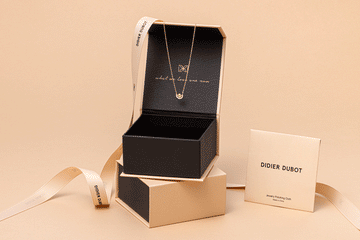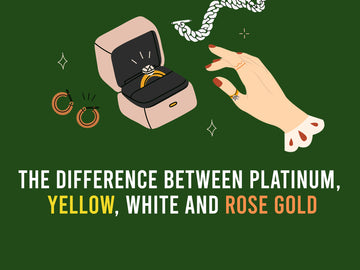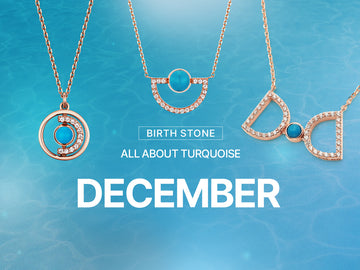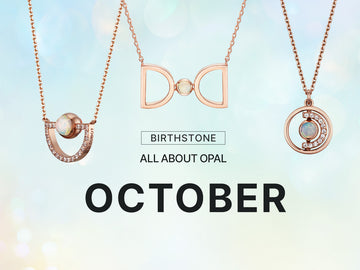Have you ever wondered about the differences between gold and platinum? Both are luxurious materials that act as beautiful bases for rings, necklaces, earrings, and bracelets. You may think that the only difference between platinum and gold is color, but there are actually several factors that distinguish the two metals. Below we’re sharing the main difference between platinum, yellow, white, and rose gold.
What Is Platinum?
This lustrous white metal is a favorite choice for fine jewelry. It’s rarer, heavier, and harder than gold. These attributes have made platinum synonymous with exclusivity and prestige. In fact, some people consider platinum to be more luxurious than gold. Think of platinum club memberships or credit cards; they’re generally only available to a select number of individuals and come with the highest level of benefits.
Does this mean that platinum is better than gold? Not necessarily. Both metals are high quality materials that come with their own unique benefits. Figuring out which metal is best for you just depends on your needs and preferences.
The Pros and Cons of Platinum Jewelry
Pros: Durability and hypoallergenic qualities
Due to its dense nature, platinum is one of the most durable metals available for jewelry. For example, platinum earring backs are less likely to break or wear away than gold earring backs.
Platinum’s density means that more of it can be used during jewelry creation. As a result, platinum jewelry contains fewer alloy metals. This is great news for anyone with sensitive skin. Gold jewelry has a higher composition of alloy metals, which can often irritate the skin. Platinum is a naturally hypoallergenic choice.
Cons: More susceptible to scratches and dullness
Contradictory as it sounds, platinum is actually softer than gold. It’s true that platinum is a more durable option, but it’s also more prone to scratches. Platinum jewelry should be cleaned and polished every few years to maintain its luster.
Gold Vs Platinum: The Key Differences
Composition
This is perhaps the biggest difference between gold and platinum. Jewelry composition plays an important role in other factors, like price and comfort. Gold jewelry is rarely made of a pure, or 24K, composition. It’s combined with other durable metals that increase the strength and durability of gold. Gold jewelry can come in a few different purity levels, but 14K (58.3% pure gold) and 18K (75% pure gold) are the most popular choices for fine jewelry. You can learn all about 14K gold here.
Platinum jewelry can be created with a significantly higher purity level. The metal’s dense nature allows for jewelry to be made with purity levels of 95-98%. The remaining percentage consists of silver and rhodium. The high purity content influences the price of platinum, making it the more expensive choice. Sometimes platinum jewelry can be double the price of white gold jewelry!
Although a higher purity content sounds like a desirable attribute, it doesn’t necessarily make platinum better than gold. 14K or 18K white gold is more resistant to scratches than platinum. Owners of platinum jewelry will probably find themselves spending more time on upkeep and maintenance in the long run.
Comfort
Platinum weighs more than gold, which makes platinum jewelry heavier than gold jewelry. Your personal preference will determine if this is a good or a bad thing. Some people will enjoy the density of a platinum piece, while others will find lightweight gold to be more comfortable.
Color: Yellow, White, and Rose Gold
Color is the biggest discernible difference between platinum and gold. Platinum is famous for its cool, silvery tone, while gold comes in three different options.
Yellow gold is likely what comes to mind when you think of the precious metal. Jewelry made from yellow gold consists of pure gold and alloys like copper and zinc. Famous for its rich and warm color, yellow gold tends to be most flattering on darker skin tones.
Rose gold is considered the most feminine type of gold with its sweet pink color. It can come in many different shades, ranging from soft pink to reddish hues. Rose gold is created by blending pure gold with a copper alloy. The more copper the composition contains, the redder the metal will appear. Rose gold is an increasingly popular option that complements most skin tones. Copper is a relatively cheap alloy metal, which tends to make rose gold the most affordable choice. The biggest downside is that copper can sometimes cause irritation, so rose gold probably isn’t a great choice for those with sensitive skin.
Composed of pure gold and silvery alloy metals like nickel and silver, white gold is almost identical to platinum on a visual level. The untrained eye will struggle to differentiate the two. If you prefer a silvery tone, white gold is an excellent affordable and scratch-resistant alternative to platinum.
Now that you know the difference between platinum, yellow, white, and rose gold, which option will you choose?
Writer: Maria Polansky

















